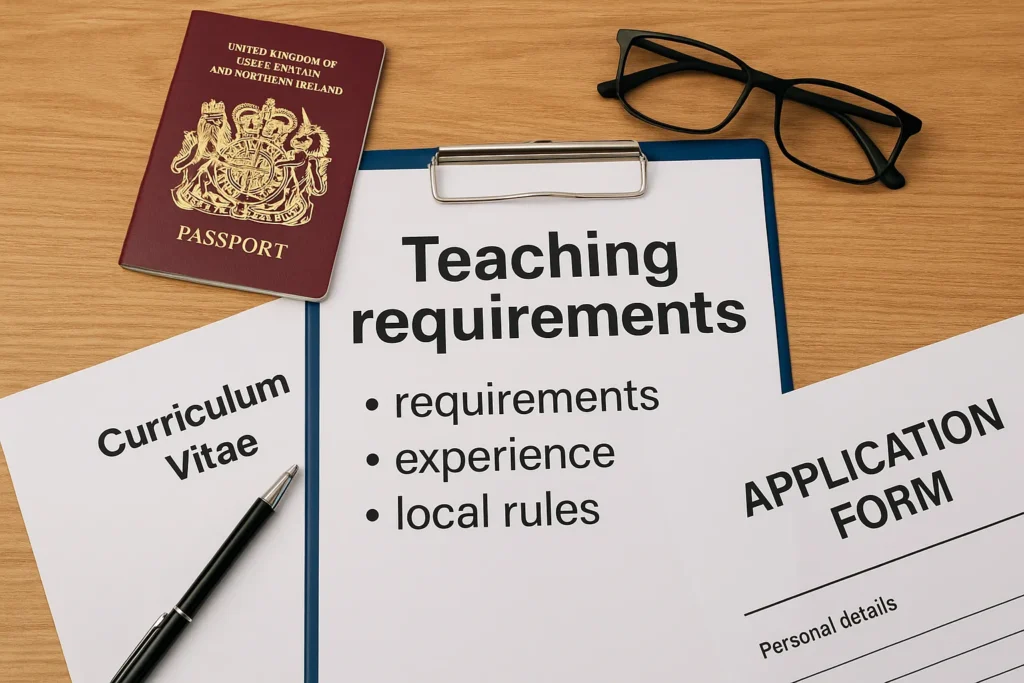Have you spent hours researching UK teaching jobs, only to feel more lost than when you started? Well, you’re in the right place.
We’ve been helping overseas teachers understand the UK system and find the right teaching jobs for many years. Much of the confusion comes from the unfamiliar terms: QTS, skilled worker visas, and safeguarding checks.
But what do these mean for teachers trained abroad? And which qualifications hold weight in England, Scotland, Wales, or Northern Ireland?
In this guide, we’ll explain all of these terms and guide you through QTS and visa sponsorship requirements.
Let’s start by looking at the essentials all non-UK teachers need to start teaching in the UK.
What Non-UK Teachers Need to Start Teaching in the UK

To start, you’ll need to meet requirements, prove experience, and follow local rules to get your teaching qualifications recognised in the UK.
We’ll explain what that involves in this section.
Qualified Teacher Status (QTS) Explained
QTS is the official certification that proves you meet England’s teaching standards. Most state schools in England require it, along with special schools that receive government funding. Without it, your career options become quite limited after your first four years.
But you can actually work in England for up to four years without QTS under what’s called the 4-year rule, so you have space to apply while gaining UK classroom experience. Once that window closes, you’ll need QTS to keep working in maintained schools.
So what does applying for QTS actually involve?
First off, your bachelor’s degree must match UK standards, which you’ll verify through an organisation called UK ENIC. You’ll also need to hold a professional teaching status in your home country with no restrictions on your practice. Plus, your qualifications must show you can teach children aged 5 to 16.
Pro tip: Applications usually take up to 12 months unless you’re already employed in England, in which case assessment is quicker.
Recognised Teaching Qualifications
Not every country’s teaching credentials qualify for direct QTS application. The UK government keeps a list of eligible countries, including Australia, Canada, New Zealand, and the United States.
But teachers from Ghana, India, Jamaica, Nigeria, Singapore, and South Africa face some extra requirements. You must specialise in maths, science, or languages, and you need to be qualified to teach students aged 11 to 16.
Your teaching qualification also needs to meet the level 6 standards. This is roughly the same as a bachelor’s degree. The length of your training should match English initial teacher training courses as well.
Proving Your Teaching Experience
The UK Department for Education wants to see at least nine months of paid teaching work after you have qualified. This has to be actual employment as a teacher, which means classroom observations during your training or student teaching placements won’t count.
School holidays do count towards your nine months, which is helpful. But any career breaks or unpaid leave you took won’t. Fortunately, your experience can come from any country.
Regional Differences: England vs. Northern Ireland and Scotland
Here’s where things get a bit more complex: each part of the UK runs its own separate teacher registration system.
Wales is the easiest if you have an English QTS, because they automatically recognise it. Teachers can also move between England and Wales without any extra hassle.
Scotland operates differently. You need to register with the General Teaching Council for Scotland if you want to work there. Yes, even if you already have an English QTS, you still have to apply separately.
Northern Ireland works the same way, with its own General Teaching Council handling registrations.
These regional bodies look at each application on its own merits. So having an English QTS doesn’t guarantee they’ll approve you. You’ll need to submit your teaching qualification documents and meet whatever specific requirements they’ve set out.
Now, even with QTS sorted, you can’t actually start teaching without a proper immigration status.
Teaching Jobs in the UK: Visa Rules and Right-to-Work Checklist

Now, we’ll talk about visa requirements, sponsorship details, and how to prove you can legally work in UK schools.
The Skilled Worker Visa Route
Most overseas teachers need what’s called a Skilled Worker Visa to work in the UK. But this isn’t something you can apply for by yourself; your employer actually has to sponsor you, which means the school must hold a special worker licence from the Home Office (aka UK visa and immigration authority).
As a teacher, the salary rules (which set the minimum earnings you need to qualify for a skilled worker visa) work in your favour. Most roles require £41,700, but teachers qualify at £25,000, the relevant pay scale. But do note that, from September 2025, qualified teachers working outside London must earn at least £32,916.
And schools have to budget for this, too. The school sponsoring you will be paying between £574 and £1,579 for a worker licence, plus £525 for each Certificate of Sponsorship. There’s also an Immigration Skills Charge of £364 to £1,000 per year.
So if a small school is hiring only you as the overseas teacher on a two-year visa, they might spend around £1,827 total. As for your visa, it can last up to five years, depending on your contract.
What Immigration Status Must Include
Some visas come with restrictions on the type of work you can do or how many hours you can work. So double-check that your immigration status explicitly allows you to work as a teacher in the UK before accepting any job offer.
You also need to reapply for your visa when it expires, and your school must issue a new Certificate of Sponsorship. We recommend starting this process at least three months early to allow time for approval and prevent work gaps.
Getting Help From Recruitment Agencies
Teacher recruitment agencies can smooth out the visa sponsorship process considerably. Agencies like Quantum Scholars, Engage Education, and iCan Teach UK specialise in placing overseas teachers in UK schools. They often work directly with schools that already hold sponsorship licences.
These agencies handle much of the paperwork and can explain visa requirements in plain language. Some even arrange free consultations with immigration specialists. Just remember that agencies can’t sponsor you themselves.
Pro tip: Watch out for agencies charging excessive fees or making unrealistic promises. Legitimate agencies usually don’t charge teachers for placement services. Schools pay them instead.
Once you’ve sorted out your visa situation, your next step is deciding where to apply for jobs.
Teacher Recruitment in the UK: Jobs, Agencies and School Types

The UK education system has different types of schools, multiple ways to find vacancies, and various agencies competing for your attention. So here are your options for finding the right teaching position:
Direct Hiring vs. Recruitment Agencies
Applying directly to schools means you research schools yourself, submit applications through their websites or teaching vacancies, and negotiate your own terms. And your main advantage is avoiding fees and working directly with headteachers and school leaders.
The downside? It takes significantly more time and effort. You handle all the paperwork yourself, from visa documents to DBS checks. Plus, you might miss opportunities at schools that only work with specific agencies.
If you’d rather not do everything yourself, go with a recruitment agency. They’ll match you with schools, handle initial screenings, and often provide interview prep and CV advice.
Pro tip: Legitimate agencies shouldn’t charge teachers for placements. If an agency asks you to pay up front, that’s a red flag. Also, avoid agencies making unrealistic promises about guaranteed jobs or fast-track visas.
Where Teaching Jobs Are in High Demand
Teacher shortages aren’t the same everywhere. Some subjects and locations have more openings than others, like:
- England’s big cities, particularly London and the South East, are constantly hunting for teachers.
- Scotland’s rural areas, especially up in the Highlands and Islands, deal with serious staffing gaps. They have actually flagged chemistry, computing, Gaelic, home economics, and technological education as priority shortage subjects.
- Northern Ireland reports that 40% of schools can’t find enough physics teachers.
Physics, maths, and modern foreign languages face the worst teacher shortages right across the UK. Physics hit only 17% of its recruitment target back in 2023. And business studies did even worse at just 16%.
If you teach any of these subjects, you’ll have your pick of opportunities throughout the UK.
Your Next Steps as an Overseas Teacher in the UK
So, does all this information feel a bit less scary now? Hopefully, you’ve got a clearer picture of what the journey actually looks like.
Your first stop should be the official UK government QTS application site to check if you qualify. After that, the NASUWT union website will give you detailed guides specifically for overseas teachers.
The trusted recruitment partners we mentioned earlier can also walk you through the visa process step by step and connect you with schools that actively sponsor overseas teachers.
Ready to take the next step in your teaching career? Visit The Library Fanatic for more guidance on building your future and finding opportunities that match your qualifications and goals.


